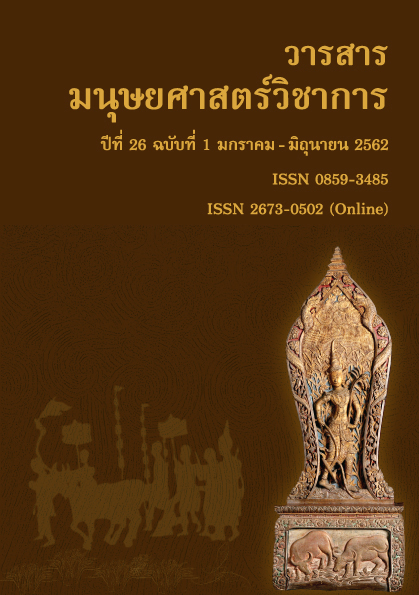From “Snake” to “Human”, from “Human” to “Snake” Ambiguity of Humanity and Animality in the Novel Na-kee
Main Article Content
Abstract
This article is an attempt to analyze the characters Chao-mae-Na-Kee and Khum-Kaew in the novel Na-kee by Tri Apirum. The key theoretical approach of this article is based on ecocriticism. This article has three main concerns: 1) the meaning of Chao-mae-Na-Kee’s taking possession of a human being, 2) Chao-mae-Na-Kee’s denial of and desire for animality. 3) the meaning of a human being’s transforming into a snake. With regard to the first point, it was found that Chao-mae-Na-Kee’s taking possession of the human Khum-Kaew in order to be born into a new incarnation represents the unity between humanity and nature. This rebirth is regarded as an abnormally by society, and so Khum-Kaew must be excluded and is despised by society. Moreover, Chao-mae-Na-Kee’s rebirth as Khum Kaew from the perspective of ecocriticism is seen as a sign of humanity’s dependence on the spirit of nature. This shows the body of a human being who has died is able to return to life through the spirit of nature. Chao-mae-Na-Kee’s denial of and craving for animality reveals Chao-mae-Na-Kee as abject. The important feature of this is that this abjection is her identity: she longs for animality but at the same time wants to eradicate it. Chao-mae-Na-Kee perhaps represents the instability of human beings, a point which demonstrates and underscores that the human body has no significance at all. In sum, this novel shows the might of nature and weakness of human beings through the characters: “Khum-Keaw” and “Chao-mae-Na-Kee”.
Article Details
References
ตรี อภิรุม. (2559). นาคี. กรุงเทพฯ: โพสต์.
พิเชฐ สายพันธ์. (2539). “นาคาคติ” อีสานลุ่มน้ำโขง: ชีวิตทางวัฒนธรรมจากพิธีกรรม ร่วมสมัย (วิทยานิพนธ์มหาบัณฑิต สาขามานุษยวิทยา). มหาวิทยาลัยธรรมศาสตร์, กรุงเทพฯ.
เมธาวี โหละสุต. (2555). อ่านไฟต์คลับ ในฐานะนวนิยายแห่งความอุจจาร. วารสารศิลปศาสตร์, 12(2), 1-45.
รชฎ สาตราวุธ. (2555). จัดการความขัดแย้งด้วยความคลุมเครือ: ข้อเสนอทางปรัชญาของ ซิโมน เดอ โบวัวร์. ใน สุวรรณา สถาอานันท์ และเกษม เพ็ญภินันท์ (บ.ก.), ข้า ค่า ฆ่า: อัตลักษณ์ คุณค่า ความรุนแรง (น. 481-552). กรุงเทพฯ: จุฬาลงกรณ์มหาวิทยาลัย.
ราชบัณฑิตยสถาน. (2545). พจนานุกรมศัพท์วรรณกรรม อังกฤษ-ไทย. กรุงเทพฯ: ราชบัณฑิตยสถาน.
วิศิษย์ ปิ่นทองวิชัยกุล. (2555). ร่างทรง: การใช้ตำนานล้านนาในฐานะอาวุธแห่งอิตถีเพศในนวนิยายสร้อยสุคันธาของมาลา คำจันทร์. ใน ตรีศิลป์ บุญขจร (บ.ก.), วารสารอาเซียน: สายสัมพันธ์และสตรีวิถี (น. 113-131). กรุงเทพฯ: แม่คำผาง.
ส. พลายน้อย. (2552). สัตว์หิมพานต์. (พิมพ์ครั้งที่ 4). กรุงเทพฯ: พิมพ์คำ.
อวยพร แสงคำ. (2557). ลักษณะเด่นของนวนิยายไทยที่มีตัวละครเป็นครุฑและนาค (วิทยานิพนธ์มหาบัณฑิต สาขาภาษาไทย). จุฬาลงกรณ์มหาวิทยาลัย, กรุงเทพฯ.
Buell, L. (1995). The Environmental Imagination: Thoreau, Nature Writing, and the Formation of American Culture. Cambridge, MA: Belknap P of Havard UP.
Buell, L., Heise, U. & Thornber, K. (2011). Literature and Environment. Annual Reviews of Environment Resources, 36, 417-440.
Cirlot, J. E. (1971). A Dictionary of symbols. London: Routledge.Merchant.
Glottfelty, C. & Fromn, H. (Eds). (1996). The Ecocriticism Reader: Landmarks in Literary Ecology. Athens: University of Georgia Press.
Kristeva, J. (1982). Powers of Horror. (Roudiez, S., L, Trans.). New York: Columbia University Press.
Lonngren, A., S. (2015). Following Animal: Power, Agency, and Human-Animal Transformations in Modern, Northern-European Literature. Newcastle: Cambridge Scholar Publishing.
Nasser, S. A. (2016). Shape-shifting as a quest for liberation, empowerment and justice: metamorphosis and therianthropy in Rawi Hage’s novels. European Journal of English Language and Literature Studies, 4(3), 1-13.
Rabibhadana, A. (1992). Tourism and Culture: Bang-Fai Festival in Esan. In Report presented in The 1992 Year-End Conference Thailand’s Economic Structure: Toward Balanced Development? TDRI, 12-13.
Roy, A. (2014). Green Poems: An Ecocritical Reading of Select Indian Poem in English. MIT International Journal of English & Language & Literature, 1(2), 92-99.
Sacknoff, L.M. (2014). Fantastic ecosemiosis: An analysis of Fantasy as nature-text in The Lord of the Rings (Thesis of Master Degree). Iowa State University, Iowa.


